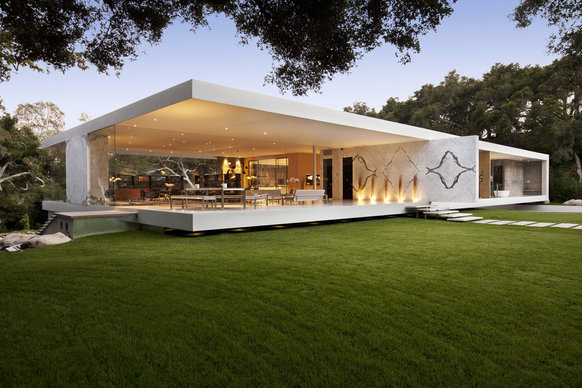
If you thought Southern California mansions could hardly get more outlandish, consider the latest must-have feature: A moat encircling the property.
Other exclusive amenities include dental chairs, botox stations and wine "cellars" that somehow made their way into the kitchen. It's all part of growing competition among designers, architects and developers for the attention of ultra-wealthy buyers.
Moats are making their biggest splash since medieval times.
At Jennifer Lopez's former home in Bel-Air, which recently resold for $10 million, an arched footbridge and a cobblestone driveway cross a stone-lined waterway that encircles the French-style villa.
In Brentwood, supermodel Gisele Bundchen and New England Patriots quarterback Tom Brady included the water element at their newly completed European-style estate. Luckily for the neighbors, the couple's moat looks more like a winding stream than a means of defense.
And at a Beverly Hills contemporary built on a promontory, a narrow one serves a practical purpose. The moat around the $36-million property takes the place of a guardrail, which would have obstructed the stellar city views.
While some over-the-top home features offer function, others are just for fun. But tastes and trends are evolving more quickly since the advent of the Internet, designers say, making it harder to keep up with the proverbial Joneses.
"You could basically take the '70s, and the whole decade looks more or less the same," designer Steve Hermann said of home amenities. "Now things are changing very quickly."
To stay in step with the times, a botox station and a dental chair are incorporated into a $65-million spec house in Beverly Crest. Should they fail to entice a buyer unwilling to brave the hoi polloi, perhaps the his and her bars will.
"The developer is trying to come up with something to set his house apart," Hermann said. "It remains to be seen if the buyer will actually use the amenities."
Hermann, a Beverly Hills designer who has worked on homes for such notables as singer Christina Aguilera and fashion designer Vera Wang, sometimes tries his ideas out in his own living space. At his Glass Pavilion in Montecito, which sold in October for $12.9 million, he moved the wine "cellar" into the kitchen and stretched the glass-fronted, temperature-controlled space along one wall.
"People spend an infinite amount of money on wine," Hermann said. "Why would you want it two floors underneath where you are?"
Instead, he viewed a wine display as part of the entertainment during parties. "It seemed like a fun idea," he said of the 3,000-bottle wine storage area.
For clients, he has transformed closets into the equivalent of luxurious showrooms, wrapping every surface in hand-stitched leather.
"They become like actual display rooms," Hermann said. "Guests will come over and you'll show off your closets."
Extravagant features enable spec builders hemmed in by lot size and regulations to push the asking price per square foot, Hermann said. "You are limited by how much you can build."
Because of building height restrictions in Malibu, for example, luxury builders will often put basements in homes to increase the living space. Then it's up to local architects such as Doug Burdge to come up with ideas on how best to use the square footage.
Burdge has designed homes along Malibu's celebrity-row beaches with Italian-style wellness suites where hairdressers, fitness trainers and masseuses can come to the homeowner out of sight of the paparazzi. Light wells and garden rooms make the stylized spaces feel anything but subterranean.
For car collectors, Burdge creates a garage space that resembles a paneled and carpeted showroom.
For the bejeweled, his designs have included walk-in safes where the owner's valuables are displayed on shelves. "The safe room can be small," he said, "yet it creates a nice amenity that can be used for important papers or other things."
What's mind-blowing to local luxury home buyers, however, may seem somewhat provincial to what's being built elsewhere.
Kenneth Bordewick, who heads a design group bearing his name and is chief executive of Beverly Hills Luxury Interiors, has created such distinct spaces as a $17-million hand-carved bathroom and a poker room complete with a jewel-inlaid table.
Raising the bar even further may be bedrooms he has worked on in homes at undisclosed locations east of the Mississippi River. With a push of a button, secret panels move aside to reveal a fully equipped intensive-care unit.
"If the owner goes to the hospital, the stock market could crash and a company may flounder," Bordewick said. Instead, the person can be diagnosed and treated on site as a doctor advises remotely.
But not everyone buys the idea that packing a house with outrageous amenities sells real estate. Spec builder Stefano Marciano of Estate Four is nearing completion on a $50-million mansion on 3.6 acres in Holmby Hills envisioned for a billionaire art collector. The contemporary, which he likens to "a Richard Neutra on steroids," features 14- and 20-foot ceilings throughout and expansive gallery space.
"The buyer will usually have their own vision, and this allows for some personalization," he said of the 20,000-square-foot house, which includes a media room, a wine cellar and a meditation and massage room. "This is more like a blank canvas."



Reader Comments
to our Newsletter